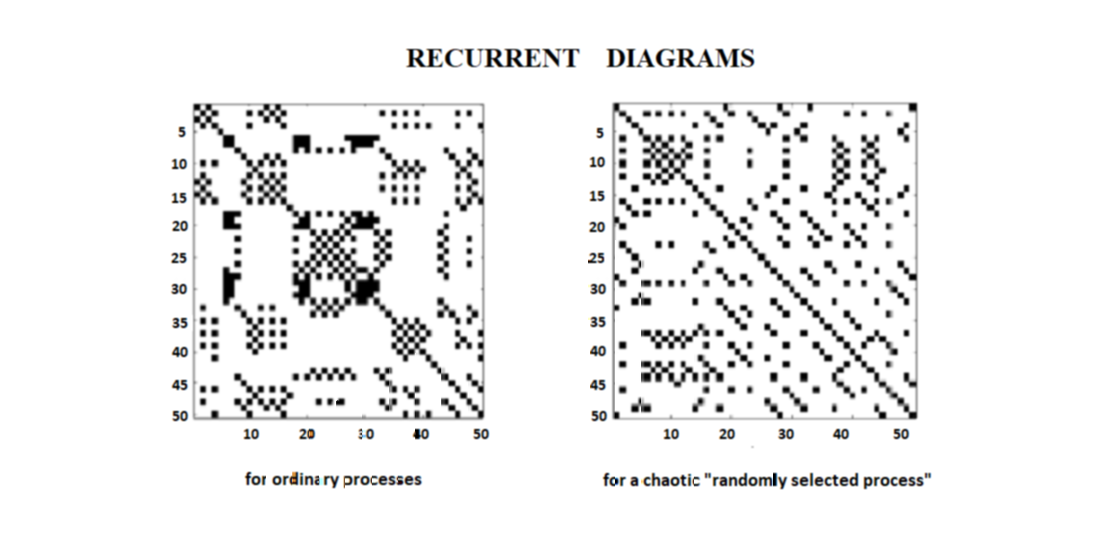The effect of noise on recurrent diagrams of energy consumption of a metallurgical enterprise
DOI:
https://doi.org/10.15587/2706-5448.2024.309790Keywords:
recurrent analysis, network traffic, time series, recurrent diagram, energy consumption, nonlinear dynamics, metallurgyAbstract
The most common problem faced by modern metallurgical enterprises is the improvement of their energy efficiency, which is based on the management of energy-saving projects. The paper deals with the analysis of the impact of external noise on recurrent diagrams based on short-term time series of daily energy consumption of a metallurgical enterprise. The object of this study is short time series of energy consumption of a metallurgical enterprise. The time series of energy consumption of PJSC «Electrometallurgical Plant «Dniprospetsstal» (Ukraine) for 2018–2021 were used as data. The subject of the study is the method of recurrent diagrams of short time series.
In the process of research, methods of short time series analysis based on recurrent analysis were used to study the characteristics of the system state on the example of a metallurgical enterprise. An analysis of the influence of external noise on recurrent diagrams of short-term chaotic time series was carried out using the developed software in the Matlab environment for constructing recurrent diagrams of energy consumption of a metallurgical enterprise.
The following tasks were solved in the work: software was developed for constructing recurrent diagrams in the Matlab package with the possibility of analyzing changes in the magnitude of quantitative indicators of recurrent diagrams under the influence of different levels of noise in time series.
The obtained results are recommended to be used to characterize the state of the system and analyze the influence of external noise. The practical value of the performed work is determined by the proven usefulness of recurrent analysis for estimating electricity consumption and the improvement of modeling of this process, which will allow increasing the accuracy of forecasting future dynamics verified by empirical data.
References
- Kiiko, S. H. (2021). Metodolohiia predyktyvnoi adaptatsii upravlinnia portfeliamy proektiv enerhozberezhennia na metalurhiinykh pidpryiemstvakh. Doctoral dissertation; Pryvatne aktsionerne tovarystvo «Elektrometalurhiinyi zavod «Dniprospetsstal» im. A. M. Kuzmina».
- Eckmann, J.-P., Kamphorst, S. O., Ruelle, D. (1987). Recurrence Plots of Dynamical Systems. Europhysics Letters (EPL), 4 (9), 973–977. https://doi.org/10.1209/0295-5075/4/9/004
- Dotsulenko, P. A. (2013). Novi metody analizu ta prohnozuvannia chasovykh riadiv na finansovykh rynkakh. Available at: http://www.rusnauka.com/13_EISN_2013/Economics/4_136384.doc.htm Last accessed: 11.02.2024
- Marwan, N. (2007). Software. Programmes. Commandline Recurrence Plots.
- Zbilut, J. P., Webber, C. L. (2007). Recurrence quantification analysis: introduction and historical context. International Journal of Bifurcation and Chaos, 17 (10), 3477–3481. https://doi.org/10.1142/s0218127407019238
- Marwan, N. (2008). A historical review of recurrence plots. The European Physical Journal Special Topics, 164 (1), 3–12. https://doi.org/10.1140/epjst/e2008-00829-1
- Zou, Y., Romano, M. C., Thiel, M., Marwan, N., Kurths, J. (2011). Inferring indirect coupling by means of recurrences. International Journal of Bifurcation and Chaos, 21 (4), 1099–1111. https://doi.org/10.1142/s0218127411029033
- Thiel, M., Romano, M. C., Kurths, J., Meucci, R., Allaria, E., Arecchi, F. T. (2002). Influence of observational noise on the recurrence quantification analysis. Physica D: Nonlinear Phenomena, 171 (3), 138–152. https://doi.org/10.1016/s0167-2789(02)00586-9
- Zhou, Y., Zhu, R., Zhao, H., Zuo, X. (2022). Influence of noise on wear fault diagnosis based on recurrence plot. Measurement, 205, 112158. https://doi.org/10.1016/j.measurement.2022.112158
- Garcia-Ochoa, E. (2020). Recurrence plots: A new methodology for electrochemical noise signal analysis. Journal of Electroanalytical Chemistry, 864, 114092. https://doi.org/10.1016/j.jelechem.2020.114092
- Kyselev, V. B. (2007). Opredelenye stabylnosty traektoryy protsessa v fazovom prostranstve pry pomoshchy rekurrentnoho analyza. Nauchno-tekhnycheskyi vestnyk ynformatsyonnikh tekhnolohyi, 6 (40), 121–130.
- Ramdani, S., Bouchara, F., Lesne, A. (2018). Probabilistic analysis of recurrence plots generated by fractional Gaussian noise. Chaos: An Interdisciplinary Journal of Nonlinear Science, 28 (8), 92–121. https://doi.org/10.1063/1.5030522
- Eckmann, J.-P., Kamphorst, S. O., Ruelle, D. (1987). Recurrence Plots of Dynamical Systems. Europhysics Letters (EPL), 4 (9), 973–977. https://doi.org/10.1209/0295-5075/4/9/004
- Webber, C. L., Zbilut, J. P. (1994). Dynamical assessment of physiological systems and states using recurrence plot strategies. Journal of Applied Physiology, 76 (2), 965–973. https://doi.org/10.1152/jappl.1994.76.2.965
- Kot, M. (2001). Elements of Mathematical Ecology. Cambridge: Cambridge University, 648. https://doi.org/10.1017/cbo9780511608520
- Bakurova, A., Divocha, I., Kiyko, S., Yuskiv, O. (2023). Recurrent analysis of energy consumption of a metallurgical enterprise. Innovative Technologies and Scientific Solutions for Industries, 1 (23), 14–24. https://doi.org/10.30837/itssi.2023.23.014

Downloads
Published
How to Cite
Issue
Section
License
Copyright (c) 2024 Anna Bakurova, Olesia Yuskiv

This work is licensed under a Creative Commons Attribution 4.0 International License.
The consolidation and conditions for the transfer of copyright (identification of authorship) is carried out in the License Agreement. In particular, the authors reserve the right to the authorship of their manuscript and transfer the first publication of this work to the journal under the terms of the Creative Commons CC BY license. At the same time, they have the right to conclude on their own additional agreements concerning the non-exclusive distribution of the work in the form in which it was published by this journal, but provided that the link to the first publication of the article in this journal is preserved.








